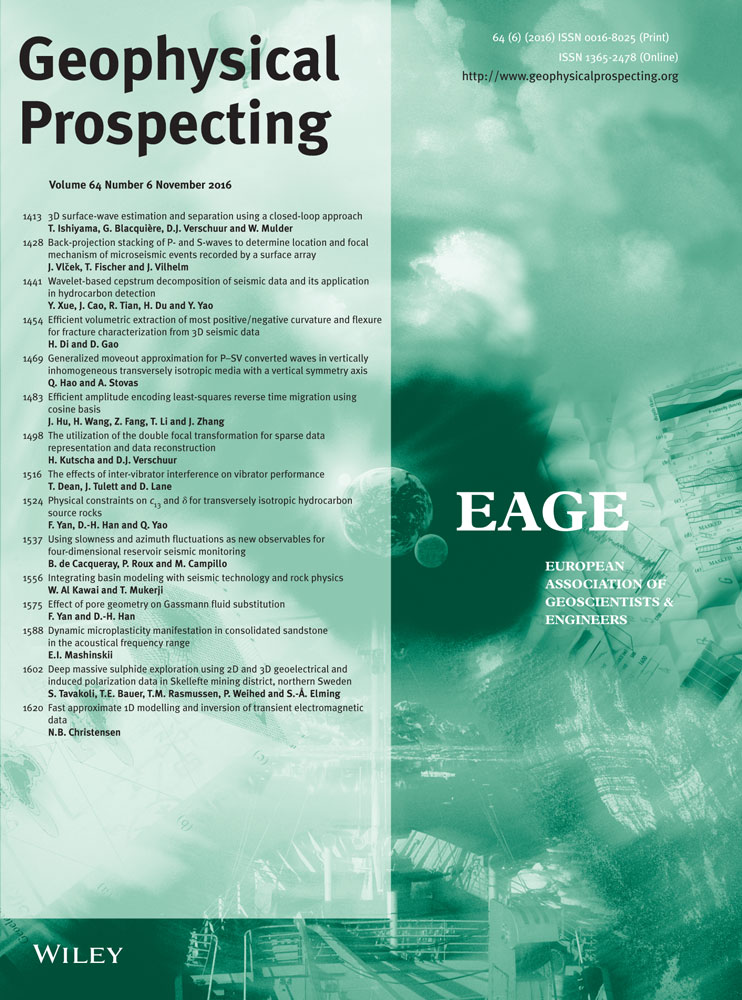Deep massive sulphide exploration using 2D and 3D geoelectrical and induced polarization data in Skellefte mining district, northern Sweden
ABSTRACT
Geoelectrical and induced polarization data from measurements along three profiles and from one 3D survey are acquired and processed in the central Skellefte District, northern Sweden. The data were collected during two field campaigns in 2009 and 2010 in order to delineate the structures related to volcanogenic massive sulphide deposits and to model lithological contacts down to a maximum depth of 1.5 km. The 2009 data were inverted previously, and their joint interpretation with potential field data indicated several anomalous zones. The 2010 data not only provide additional information from greater depths compared with the 2009 data but also cover a larger surface area. Several high-chargeability low-resistivity zones, interpreted as possible massive sulphide mineralization and associated hydrothermal alteration, are revealed. The 3D survey data provide a detailed high-resolution image of the top ∼450 m of the upper crust around the Maurliden East, North, and Central deposits. Several anomalies are interpreted as new potential prospects in the Maurliden area, which are mainly concentrated in the central conductive zone. In addition, the contact relationship between the major geological units, e.g., the contact between the Skellefte Group and the Jörn Intrusive Complex, is better understood with the help of 2010 deep-resistivity/chargeability data. The bottommost part of the Vargfors basin is imaged using the 2010 geoelectrical and induced polarization data down to ∼1-km depth.
INTRODUCTION
The Skellefte mining district in northern Sweden hosts approximately 80 known volcanogenic massive sulphide (VMS) deposits (Fig. 1; Kathol and Weihed 2005). Currently, five VMS deposits are mined in the area: Kristineberg, Renström, Kankberg, Maurliden West, and Maurliden East, producing Zn, Cu, Pb, Ag, Te, and Au (Fig. 1). In addition, an orogenic gold deposit (Au) is mined at Björkdal.
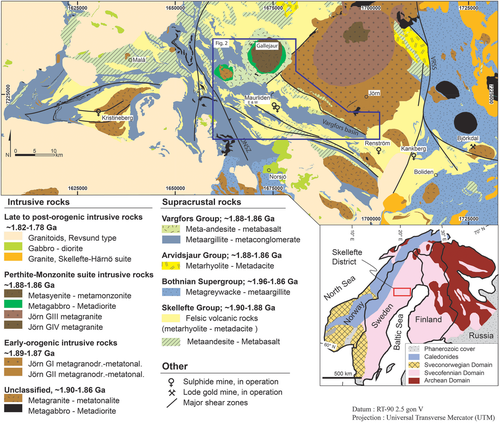
The economic importance of the area led to numerous geological and geophysical activities in order to understand its geological evolution and hence targeting new ore deposits (Padget, Ek, and Eriksson 1969; Allen, Weihed, and Svenson 1996; Weihed 2010; Bauer et al. 2011, 2013; Dehghannejad et al. 2012; Skyttä et al. 2012; Tavakoli, Elming, and Thunehed 2012b; Tavakoli et al. 2012a; García Juanatey 2012). A general need to explore and map structures at larger depth, e.g., down to ∼5 km, is discussed in de Kemp et al. (2011) and Tavakoli et al. (2012a, b). This interest in studying deeper targets led to several joint geophysical studies (e.g., Malehmir et al. (2007); Hübert et al. (2009); Malehmir, Thunehed, and Tryggvason (2009); and Tavakoli et al. (2012a, b)), which were successful in detecting high strain zones related to the sulphide mineralization and visualizing lithological contacts. Geoelectrical surveys with subsequent data inversion have previously succeeded in visualizing complicated subsurface geometries (Wong and Strangway 1981; Li and Oldenburg 2000; Magnusson, Fernlund, and Dahlin 2010; Commer et al. 2011) and are considered as a relatively new but useful technique in mineral exploration (Phillips et al. 2001), particularly in the areas where resistivity contrast in the lithologies is significant (Sultan et al. 2009).
A geoelectrical/induced polarization (IP) campaign in the central Skellefte District was conducted in 2009 along two sub-parallel profiles I and II to model the subsurface geology around the Vargfors basin (Fig. 2; Tavakoli et al. 2012b). The success of this campaign in detecting three highly conductive zones (Tavakoli et al. 2012b) and the high demand to target the ore at greater depths was the main motivation for conducting the new 2010 geoelectrical/IP field work to study the ore-hosting structures.
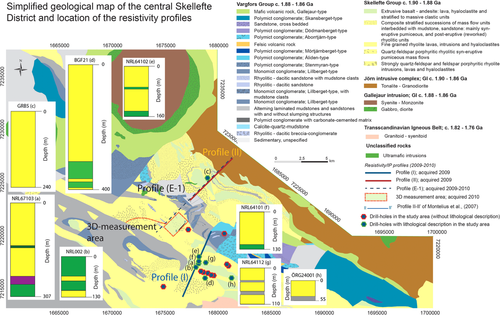
This study presents the results from geoelectrical/IP field campaign in 2009 and 2010 (profiles I, II, and E-1) and modelling and interpretation of a 3D geoelectrical /IP measurements in the Maurliden area (Fig. 2). The 2009 (2D) and 2010 (2D and 3D) geoelectrical/IP data are then integrated to check for eventual correlations between different data.
Malmqvist (1978) utilized the IP method to differentiate between mineralization types in northern Sweden. Although the co-occurrences of graphitic schist with sulphide mineralizations, both indicating a high-chargeability signature, often mask the related massive sulphide deposit (Salmirinne and Turunen 2007), the IP method is the best proven technique to differentiate between these two (Padget et al. 1969). Therefore, even if the geoelectrical/IP techniques do not entirely succeed to directly detect the VMS ore, they are still capable of delineating the ore-bearing horizons and high-strain zones, hence aiding mineral exploration (Oldenburg et al. 1998).
This study thus aims at (i) integrating 2D geoelectrical/IP data from 2009 and 2010 to verify and improve the present understanding of the subsurface resistivity/chargeability distribution and also to detect ore-bearing high-strain zones (cf., Sandrin and Elming 2007) in the central Skellefte District; (ii) better understanding the contact relationship between major lithological units and confirming or otherwise improving previous interpretations using shallow resistivity/chargeability data; (iii) investigating the possibilities for detecting new mineralizations at greater depths (down to ∼1.5-km depth) along profile E-1; and finally (iv) modelling and interpreting the 3D geoelectrical/IP response of the Maurliden mineralization system within the top 450 m of the crust to prospect new mineralization and to delineate the geometry of the known Maurliden deposits.
GEOLOGICAL SETTING
The metasedimentary Bothnian Supergroup to the south of the Skellefte District is suggested to form the basement to the lowest stratigraphical unit in the study area, the 1.9 Ga–1.88 Ga Skellefte Group (Billström and Weihed 1996; Montelius 2005; Skyttä et al. 2011; Skyttä et al. 2012). The Skellefte Group is composed of mainly felsic volcanic and volcaniclastic rocks (Allen et al. 1996) and is overlain conformable to unconformable by the mainly sedimentary Vargfors Group (Allen et al. 1996; Bauer et al. 2011). The lowermost parts of Vargfors Group are dominated by turbiditic mudstones and sandstones and monomict conglomerates located throughout the study area, whereas the upper parts of the stratigraphy are dominated by polymict conglomerates restricted to the Vargfors basin in the northern part of the central Skellefte District (Bauer et al. 2013). Intrusive rocks in the study area are dominated by the 1.89–1.87 Ga early-orogenic Jörn-type intrusive rocks (Wilson et al. 1987; González-Roldán 2010; Skyttä et al. 2011).
Structures in the study area are characterized by a distinct pattern of NNW–SSE striking normal faults and NE–SW striking transfer faults that formed during crustal extension (Bauer et al. 2011; Skyttä et al. 2012). Volcanogenic massive sulphide deposits in the Skellefte District formed as sub-seafloor replacement within volcaniclastic sediments in the uppermost parts of the Skellefte Group stratigraphy (Allen et al. 1996). Allen et al. (1996) and Bauer et al. (2013) inferred that the ore-forming hydrothermal fluids utilized the syn-extensional faults as fluid conduits and the ore-forming minerals precipitated in the vicinity of these faults.
METHOD AND RESULTS
The geoelectrical measurements (often loosely referred as resistivity measurements) are conventionally conducted by injecting a direct current or a low-frequency alternating current (I) into the ground through two metallic electrodes (current electrodes). The resulting potential distribution (ϕ) is then measured by means of two additional electrodes (potential electrodes; Parasnis 1997). The potential difference is then measured, and results are presented as apparent resistivities. The same electrode configuration is used to acquire both apparent resistivity and induced polarization (IP) data. The time-domain IP phenomenon is the cause of the voltage decay after current turn-off. When the transmitted current to the ground is switched off, the measured potential difference starts to decay to zero. The decay is either related to (i) presence of the clay minerals in the rock or sediment (membrane polarization) or (ii) presence of the conductive minerals in rocks (electrode polarization) such that the current flow is partly electrolytic (through groundwater) and partly electronic (through the conductive mineral). This effect is of particular interest in surveys for metallic minerals such as disseminated sulphides.
In general, even low sulphide concentration such as porphyry copper mineralization and pyritic alteration, which is related to some gold deposits, is likely to be well detected with the IP method. Pyrite, pyrrhotite, and graphite, all regarded as non-economical minerals, are among the most common electronic conducting minerals; this may make the interpretation of the IP data more complicated when targeting, e.g., volcanogenic massive sulphide (VMS) ore deposits (Madden 1985).
Simple geological problems can be imaged by 2D data. However, where geological constraints are not sufficient or geology is complex, 3D data are preferable, although the 3D field measurements are more costly and time consuming (Storz, Storz, and Jacobs 2000; Phillips et al. 2001; Rutley, Oldenburg, and Shekhtman 2001). Processing and interpretation of the 3D resistivity/IP data can be challenging, e.g., the inversion algorithms for processing the 3D resistivity/IP data allows the model resistivity values to vary in all three directions (x, y, and z), which is in contrast to the 2-D inversions where the resistivity values vary in the x-and z-directions and are constant in the y-direction. Moreover, inversion of the 3D data is more time consuming compared with the conventional 2D data inversions as 3D surveys often involve a large number of electrodes and measurements (Li and Oldenburg 2000).
All field measurements were carried out using the Scintrex IPR-12 time-domain resistivity/IP receiver that accepts signals from up to eight potential dipoles simultaneously and a Scintrex IPC7 2.5-kW transmitter (IPR-12 manual 1997). Eleven time windows were simultaneously measured for each dipole (between 50 ms and 1770 ms, and the widths of the slices were 20 ms, 40 ms, 40 ms, 80 ms, 80 ms, 140 ms, 140 ms, 230 ms, 230 ms, 360 ms, and 360 ms). The receive time was set to 2 seconds. The IP cycle time was 8 second, i.e., 2s positive 2s off 2s negative 2s off.
The profiles were measured using a pole–dipole electrode configuration with different approaches, i.e., fixed/variable potential dipole lengths (Px-Py), fixed/variable current-potential electrode distance (C1-P1), forward/forward–reverse measurements, and 2D/3D survey (Fig. 3).
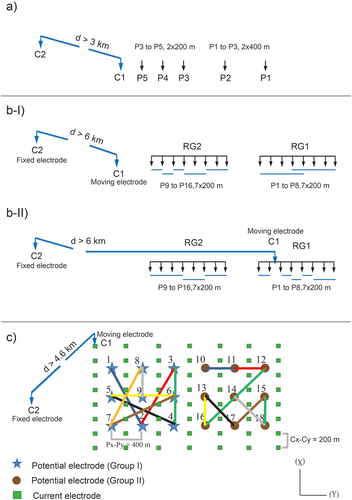
In IP surveys, the electromagnetic (EM) coupling between the IP transmitter and receiver circuits can affect the measured data, particularly for surveys with great investigation depths. However, the good horizontal coverage and higher signal strength of the pole–dipole method, as well as its lower EM coupling due to the separation of the circuitry of the current and potential electrodes compared with other electrode arrays, make this array attractive. Details on the electrode configuration are provided in Table 1 and Fig. 3.
| Survey profiles | Length/Surface coverage area (km) | Electrode array | Dipole length (km) | Number of Potential electrodes (P) | Measured data | Year measured | C1-C2 (km) | Actual investigation depth (km) | Effective interpretation depth (km) | Current injected (mA) | IP domain (mS/S) | |
|---|---|---|---|---|---|---|---|---|---|---|---|---|
| (I and II) | P (I)= 6.8 | P (II)=5.6 | Pole-dipole | 0.2-0.4 | 5 | Res + IP | 2009 | 3 | 0.8 | 0.43 | 400-1600 | Time |
| (E-1) | (E-1) = 10 | Pole-dipole | 0.2-0.8 | 16 | Res + IP | 2010 | 6 | 2.2 | 1.5 | 150-2300 | Time | |
| 3D | 3.36 km2 from which 2.16 km2 covers the interpretation area | Pole-dipole | 0.4-1.1 | 18 | Res + IP | 2010 | 4.6 | 0.45 | 0.45 | 500-2600 | Time | |
We followed three interpretation approaches: (i) shallow 2D models along profiles I and II; (ii) deeper 2D model along profile E-1; and (iii) 3D model in an area nearby the Maurliden deposits.
PROFILES I AND II
The 2009 data were collected and modelled by Tavakoli et al. (2012b). Using a pole–dipole array, the survey was carried out in such a way that geological features with a lateral extension (d) ≥ 100 m could be mapped down to 430 m in depth (Table 1; Fig. 3a; Tavakoli et al. 2012b). To reduce the survey time and, therefore, additional costs, the measurements for profiles I and II were conducted only in a forward direction. The inversions of profiles I and II were carried out using Res2Dinv (Loke 2012) with standard least square method. Inversions of profiles I and II are summarized after Tavakoli et al. (2012b), and the raw and inverted sections are shown in Figs. 4a, 4b, 6a, and 6b. The result provided a high-resolution image of the subsurface down to 430-m depth, and three alteration halos, which can be associated with mineralization (e.g., Norrliden-N deposit) were outlined along profile I (Fig. 6a-I and 6a-II). Besides, a zone with high conductivity was indicated along profile II at x = 1 km–1.7 km with an upper boundary at 400-m depth and continuing downwards (Fig. 6b-II). For details on acquisition and inversion, see Tavakoli et al. (2012b).
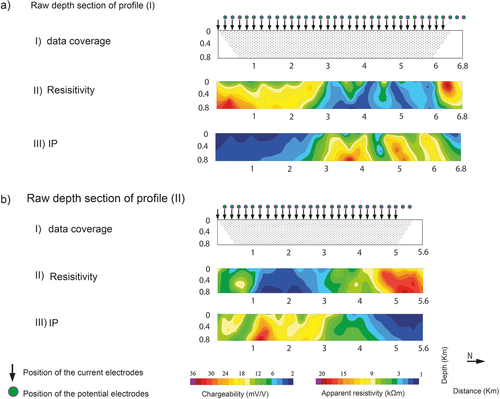
PROFILE E-1
In order to image the spatial relationship between key geological units and to better understand the spatial patterns of potential VMS hosting structures at greater depths, a geoelectrical survey was performed in 2010 to extend profile II to the SW, as well as re-measuring profile II using a multiple-electrode array (profile E-1; Fig. 2 and Fig. 3b-I and 3b-II). Profile E-1 provides (i) a deeper image (down to ∼1.5 km) and a longer lateral coverage than profile II; (ii) a nearly parallel profile to profile I to correlate anomalies that occur between the two profiles to gain a better understanding of the geometry and spatial distribution of the high-chargeability anomaly in profile II (Tavakoli et al. 2012b); and finally (iii) remove or decrease in the asymmetrical anomaly shape, which can be caused by the pole–dipole method by using forward and reverse measurements.
Data acquisition
As a basic setting for the pole–dipole method, the grounding of the remote (fixed) current electrode (C2) was set at > 6 km from the moving electrode (C1) (Fig. 3b-I). The data were measured using an IPR-12 receiver (IPR-12 manual 1997) in the field. One to eight potential dipoles were measured simultaneously. Input impedance was set to 16 MΩ, and chargeability can be detected within the range of 0 mV/V–300 mV/V. Two groups of receivers consisting of potential electrodes (RG1 and RG2; Fig. 3b-I and 3b-II) were located 400 m apart (Table 1). Each group of receivers encompassed eight potential electrodes with 200-m separation, making the total length of each dipole group 1.4 km (Fig. 3b). In contrast to the shallow 2D-measurement conducted in 2009, electrode C1 did not maintain a fixed distance to the potential dipoles; instead, C1 was moved between the dipoles. The dipole length was varied between 200 m and 800 m. The specific electrode configuration used in this survey gives a maximum penetration depth of 2.2 km, from which the top ∼1.5 km has better data coverage. We restrict the interpretation down to the 1.5-km depth. The data coverage zones and pseudosections of the resistivity and chargeability data for profile E-1 are shown in Fig. 5.
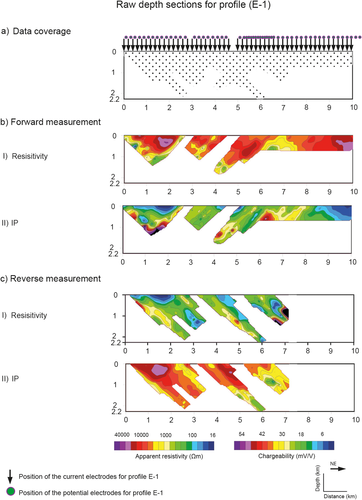
Data processing
 (1)
(1) (2)
(2) is the transpose of J, and λ is the damping (Marquardt) factor. Parameters q and g stand for the model change vector and the data misfit vector, respectively. In equation 2, Cx and Cz represent the horizontal and vertical roughness filters, respectively, and αx and αz are the relative weights given to the smoothness filters in the x- and z-directions.
is the transpose of J, and λ is the damping (Marquardt) factor. Parameters q and g stand for the model change vector and the data misfit vector, respectively. In equation 2, Cx and Cz represent the horizontal and vertical roughness filters, respectively, and αx and αz are the relative weights given to the smoothness filters in the x- and z-directions.The inversion enables users to adjust the damping factor and roughness filters to suit different types of data with different qualities. The optimization method tries to reduce the difference between the calculated and measured apparent resistivity values by adjusting the resistivity of the model blocks subject to the smoothness constraints used. A common way to measure this difference is to use the root-mean-squared (RMS) error.
We applied smoothness constraint on both model change vector and model resistivity values in order to get a smoother variation in the resistivity values. Also, the damped least square method combined with the smoothness constraint, which is expected to resolve structures where the width and thickness are smaller than the depth, was applied. According to deGroot-Hedlin and Constable (1990), it is extremely difficult to find a model that fits the data well if the data errors are underestimated. Since the field data were proven to be not completely noise-free by repeated measurements in the field, we used relatively large values for the initial and minimum damping factors. The best way to determine the optimal damping factors is to try different damping factor values while other parameters remain unchanged (Sasaki 1992). After trying different values and running the inversion, the initial and minimum damping factors were set to 0.12 and 0.03, respectively (the allowed range for the initial and minimum damping factors in Res2Dinv is 0.05–0.25 and 0.01–0.1, respectively).
Since the model did not indicate any irregular variation in the resistivity values in the lower sections, we used the default depth weighting factor of 1.05 to compensate for the resolution loss at greater depths. We also allowed the program to determine the depth weighting factor automatically, which the resulting section was similar to when 1.05 was used. The effects of the side blocks were slightly diminished to decrease the effect of artefacts in the inversion result.
One can either choose to set a value for the RMS data misfit or alternatively use the relative changes in the RMS error between the last two iterations. The program will stop after the model indicates RMS error less than this limit. A common approach is to choose the model at the iteration after which the RMS error change is insignificant (Loke 2012). In this work, the relative changes in RMS error seems to be somewhat small moving from iteration six to seven, which is the reason that the model after the sixth iteration was selected as the final model result, even though the maximum number of iterations was set to 10. After six iterations, respective RMS errors of 7.2%, and 5.8% were achieved for resistivity and IP data.
Prominent anomalies
The resistivity and chargeability contrasts in the inverted depth sections of profile E-1 delineate the contacts between felsic and mafic Skellefte Group volcanic rocks, Vargfors Group sedimentary rocks, and the Jörn intrusion (Fig. 6c). However, detailed interpretation of the conductive zones, (e.g., graphitic schist or VMS deposits) is better indicated in the IP data by six high-chargeability zones labelled S1–S6 (Fig. 6c-II). To the SW at approximate profile coordinate x = 0.6 km, a resistivity/chargeability contrast separates the sandstone–mudstones (Vargfors Group) from felsic volcanic rocks (Skellefte Group) (Fig. 6c). The significantly lower resistivity of the sandstone–mudstone (∼4 kΩm; Fig. 6c-I) compared with the resistivity of the felsic volcanic rocks (∼11 kΩm; Fig. 6c-I) is in agreement with the corresponding resistivity measured on drill-core samples in the laboratory (Tavakoli et al. 2012b). The IP data, however, do not indicate any clear signature along this contact. Further towards NE, a high-resistivity material located between x = 0.7 km and 2.2 km (upper U1; Fig. 6c-I) is either an indication of unaltered felsic volcanic rocks, which according to Tavakoli et al. (2012b) underlie major parts of the Vargfors basin in this part, or a layer of andesite/basalt with high resistivity. The dominant lithology throughout profile E-1 is felsic volcanic rocks.
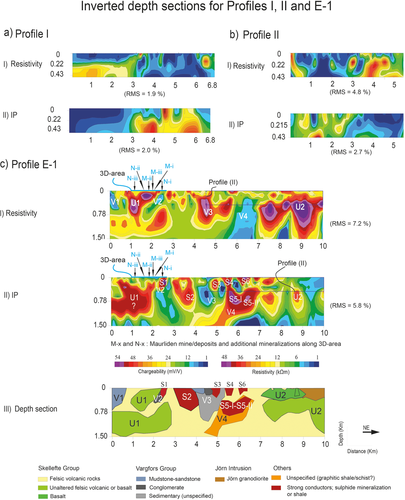
One of the key lithological contacts in this study is the contact between the Skellefte Vargfors Group. The relatively conductive structure at x = 2.2 km with a SW dip (V2; Fig. 6c) depicts the Vargfors Group sedimentary rocks. The underlying felsic volcanic rocks of the Skellefte Group can be seen at x = 2.6–2.9, which is also confirmed by drill-hole GRB5 (Fig. 2). Also, the Vargfors basin, with inhomogeneous resistivity (see Tavakoli et al. 2012b), is imaged at x = 3.7 km–5.3 km (V3; Fig. 6c).
V4, which is characterized by low resistivity and high chargeability, forms a clear boundary with its surrounding structures and can represent either a graphitic shale or alteration halo that encompasses sulphide deposits and is most pronounced between 0.5-km and 1-km depths (Fig. 6c).
Occurrences of the Skellefte Group basalts among the Jörn igneous complex were already observed, indicating high resistivities within the Jörn Intrusive rocks (Tavakoli et al. 2012b). Among the four phases of the Jörn intrusive complex (Wilson et al. 1987), the older GI and GII phases, which are cut by profile E-1, are predominantly composed of granodiorites, which is consistent with the resistivity and chargeability values observed on profile E-1 and previous interpretations by Tavakoli et al. (2012b).
3D DATA
Data acquisition
The 3D field survey was carried out using a grid of 56 current electrode positions (7×8 electrodes; C1–C56; Fig. 3c) with 400 m×200 m spacing in the x- and y-directions, respectively. Similar instruments as for profile E-1 were used in the 3D survey. Two groups of potential electrodes, each consisting of nine electrodes, were located 400 m apart from the neighbouring potential electrodes in x- and y-directions (Table 1; Fig. 3c). There are a number of repeated measurements in each setting of the electrodes. The voltage difference between different dipoles is measured against each current electrode. For every current electrode (Cx), each group of potential electrodes was set out in three different layouts, resulting in 54 measurements for each current electrode position. The fixed current electrode (C2) was set fixed 4.6 km apart from the closest potential electrode. The 3D survey covers a total area of approximately 3.36 km2 (2.4 km×1.4 km), from which the interpretation area limits to 2.16 km2 (1.8 km×1.2 km), since the outermost parts are poorly constrained by data compared with the central parts.
Data processing
 in the UBC-GIF code indicate the direction along which the maximum smoothness will be applied. If one of the alphas is chosen to be very small, then its corresponding function will contribute little to the minimization of the model objective function (Li and Oldenburg 1994). In other words, reducing the size of
in the UBC-GIF code indicate the direction along which the maximum smoothness will be applied. If one of the alphas is chosen to be very small, then its corresponding function will contribute little to the minimization of the model objective function (Li and Oldenburg 1994). In other words, reducing the size of  will result in smoothness in the x- and z-directions. Considering the ratio between the alpha values as
will result in smoothness in the x- and z-directions. Considering the ratio between the alpha values as  and
and  , the larger ratios imply that smoothness in the respective directions will increase. In other words, if the two alpha ratios become much larger than 1, the structure in the model is punished, and if these ratios are close to zero, then the smallest term dominates. To estimate reasonable values for the alphas, the square root of the following ratios between alphas can be considered as length scales (equations 3 and 4;
, the larger ratios imply that smoothness in the respective directions will increase. In other words, if the two alpha ratios become much larger than 1, the structure in the model is punished, and if these ratios are close to zero, then the smallest term dominates. To estimate reasonable values for the alphas, the square root of the following ratios between alphas can be considered as length scales (equations 3 and 4;  ):
):
 (3)
(3) (4)
(4)One should choose Lx to be larger than the shortest array separation. The total width of the mesh should be therefore larger than Lz and Lx. Also, Lz and Lx should themselves be larger than the mesh cell width. We therefore applied smoothing by setting the length scales to 120 m horizontally and 150 m vertically.
The resulting conductivity model was then used to construct a reference model for the chargeability inversion. The constraint set from the reference model was quite loose and was mainly applied to guide the inversion algorithm toward a solution where high-chargeability volumes should be preferred in volumes of low resistivity. The achieved RMS errors for 3D resistivity and IP data were 1.6% and 1.8%, respectively.
Prominent anomalies
A number of inhomogeneities were observed in the upper parts of the resistivity model but are probably inversion artefacts; hence, the top 50 m of the model is excluded from interpretation. Moreover, closer to the corners of the model, the inversion might have produced artefacts, which will not be interpreted due to the poor data coverage and therefore have not been considered in the interpretations.
The Maurliden domain is host to various ore mineralizations, from massive to vein style deposits, which occur sporadically within the coarse grain rhyolitic rocks of the Skellefte Group (Claesson and Isaksson 1981a, b). A central conductive zone has been identified in the central part of the 3D model (CCZ; Fig. 7). This zone extends from close to the surface down to ∼300 m in depth (Fig. 7a–7f). Two of the Maurliden deposits (Maurliden East and Central) are located within or close to this conductive zone (M-ii and M-iii; Fig. 7). Thus, M-ii and M-iii are likely to represent the alteration halos embedding these deposits. The model region nearby the Maurliden North deposit does not indicate any substantial resistivity signature, whereas low resistivities are expected due to the presence of the deposits as in M-ii and M-iii. Thus the unexpected high resistivity of M-i (50 kΩm) can imply that, unlike Maurliden East and Maurliden Central, the Maurliden North deposit is not surrounded by similar extent of alteration halo, or if it does, its dimension is smaller than what the present 3D study can detect. In chargeability models, M-i is collocated with an intermediate chargeability response (∼20 mV/V), down to 200 m in depth, which is consistent with the geometry of the Maurliden North (profiles II–II’; Montelius et al. 2007). Maurliden East, which is modelled based on the drill-core logging of the deposits and detailed mapping in the Maurliden domain along profiles II–II’ (Montelius et al. 2007), coincides with a relatively conductive zone (2 kΩm–4 kΩm; Fig. 7) and extends down to ∼200 m in depth (M-ii; Fig 7). However, the modelled depth extent of this deposit based on resistivity is slightly greater than the modelled depth extent (∼75 m) along profiles II–II’ in the study by Montelius et al. (2007). The extension of the conductive zone toward the west of M-ii is a possible westward elongation of this mineralization. However, the IP result reveals that M-ii is mainly associated with low chargeability (∼10 mV/V), which is well below the usual chargeability of the VMS deposits in the Skellefte District (Tavakoli et al. 2012b). The Central Maurliden deposit (M-iii), which is located within the westernmost part of the central conductive zone (CCZ; Fig. 7), indicates a resistivity of ∼1 kΩm. M-iii reflects the largest depth extent among the known Maurliden deposits inside the 3D frame (Fig. 7). In the chargeability model, M-iii indicates a high-chargeability and high-conductivity signature, which continues from the uppermost parts of the model sections down to ∼450 m. Apart from the conductive zones related to the Maurliden East and Central deposits, the conductivity–chargeability anomalies labelled N-i, N-ii, and N-iii (Fig. 7) all indicate high-conductivity responses. Their consistent and relatively low resistivities (≤ 2 kΩm) throughout the modelled depth are similar to the resistivity response of the Maurliden Central deposit (Fig. 7) down to ∼300 m in depth and even further. Their resistivities are also comparable with the resistivity of the sulphide mineralizations measured on drill-hole samples (Tavakoli et al. 2012b).
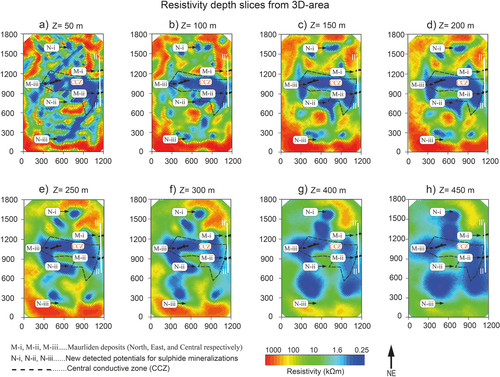
Anomalies N-i, N-ii, and N-iii (Fig. 8) all indicate a relatively high IP response (≥ 27 mV/V–70 mV/V; Fig. 8) and continue down to 450 m in depth except for N-iii, whose high chargeability does not extend further than 250 m in depth, although it might continue further dipping toward N–NW (Fig. 8f, 8g, and 8h). Therefore these three anomalies can be an indication of hitherto unknown mineralization zones in the Maurliden area.
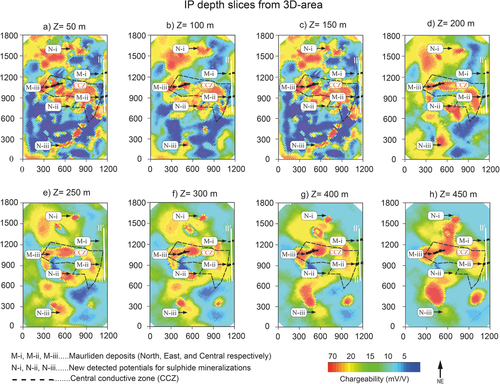
DISCUSSION AND INTERPRETATION
Physical property of rocks
Rock resistivity is a product of differences in chemical properties of the pore water, structure of pore volume, type and amount of minerals, and grain sizes (Nelson and Van Voorhis 1983; Kemna et al. 2000; Kneisel 2006). By investigating the resistivity of the rocks from laboratory measurements, one can convert and interpret the models in terms of rock type.
Tavakoli et al. (2012b) studied the physical properties of 154 drill-core samples from the central Skellefte District to constrain the interpretation of the geoelectrical and induced polarization (IP) field data. Chargeability is of particular interest in this study due to the capability of the IP technique to detect minor concentrations of highly conductive metallic minerals, which can be missed in the resistivity model (Malmqvist 1978; Loke 2012). In this study, we used resistivity/chargeability to qualitatively compare the values between the modelled field data and laboratory data. High-chargeability response may be detected in layered silicates, clays, metallic minerals, organic materials and carbon-rich deposits, and other iron-rich minerals such as ilmenite and hematite (Zonge, Wynn, and Urquhart 2005). However, according to Magnusson et al. (2010), there are additional factors that can control the chargeability within a certain rock, such as the surface area of the metallic grains (an increased surface area increases the IP response), shape of the pores, and the degree to which the pores are interconnected. According to Parasnis (1997), the latter factor is the main cause for a wide variation of resistivity/chargeability in, e.g., granite and basalts. Earlier studies proved successful in utilizing the resistivity/chargeability laboratory data to differentiate the mineralization from host rocks (Basokur et al. 1997; Tavakoli et al. 2012b). Petrophysical data in this study are used for qualitative comparison with the resistivity/chargeability values derived from field data based on the study conducted by Tavakoli et al. (2012b). The resistivity and chargeability values for different geological structures in this study are relative and correct only for this specific study area; therefore, they can be considered as either high or low elsewhere.
Vargfors Group
The resistivity and chargeability model from profile E-1 implies that Vargfors Group conglomerate (V2) dips to the SW and extends at depth down to ∼400 m (V2; Fig. 6c-III). The low resistivity of V1 (∼1 kΩm) compared to the rest of conglomerate outcropping along profile (E-1) and also compared to the typical resistivity of the Skellefte District conglomerates based on petrophysical studies (∼4.8 kΩm; Tavakoli et al. 2012b) can be attributed to differences in mineral content and/or high porosity.
The Vargfors basin is modelled by an inhomogeneous structure represented by both high- and low-resistivity/chargeability values (V3; Fig. 6c). Tavakoli et al. (2012b) suggest that the Vargfors basin close to its northern contact with Skellefte Group felsic volcanic rocks is composed of two distinct sedimentary rock types, i.e., a highly resistive sandstone in the SW and a conductive part (unspecified sedimentary rocks) to the NE, which is also supported by the new result from profile E-1. Moreover, the prominent IP anomaly (S3; Fig. 6c-II) along profile E-1 can depict a pyrrhotite or a graphitic schist. According to both resistivity and IP results, the Vargfors basin in this part of profile E-1 has a depth extent of ∼1 km (Fig. 6c-III).
Skellefte Group
Felsic volcanic rocks of the Skellefte District underlie the Vargfors basin to the SW and the Jörn Intrusion in the NE of profile E-1. The contact between felsic volcanic rocks of the Skellefte District and the embedding rocks is consistently seen in both resistivity and chargeability data (Fig. 6c). Large dipole separations or low frequency of the transmitted current in some parts can produce large areas with low resistivity (Caglar 2000), which can be observed in the pseudosection over the felsic volcanic rocks (Fig. 5b-I and 5c-I). Mafic volcanic rocks of the Skellefte Group occur often as intercalation of basalts along the contact between felsic volcanic rocks and the Jörn granodiorites (Tavakoli et al. 2012a, b). Resistivity and chargeability along profile E-1 indicate that upper parts of the U2 can depict the basalts, which partly underlie the outcropping felsic volcanic rocks and the Jörn granodiorite and appear as high-resistivity and relatively high-chargeability zones (Fig. 6c), whereas the lower part of U2 indicates a different signature that corresponds to basalt, andesite, or unaltered Jörn granodiorite. The resistivity value of the upper U2 (∼40 kΩm) agrees well with their high-resistivity response measured on drill-core samples (∼37.3 kΩm; Tavakoli et al. 2012b).
Graphitic schist or alteration halo hosting sulphide mineralization?
Anomaly V4 shares the boundary with the Vargfors basin to the SW and depicts a tectonic contact (e.g., a SW trending fault). Owing to its great depth extent (≥ 430 m), this structure was not previously detected in interpretations of profile II in the study by Tavakoli et al. (2012b). Bauer et al. (2013) suggest that the volcanogenic massive sulphide (VMS) deposit in the central Skellefte District might have formed from the fluid conduits along syn-extensional faults, which can be explained by anomaly V4 and its vicinity to the Norrliden-N sulphide mineralization (see Tavakoli et al. 2012b). The occurrences of highly conductive graphitic slates along the Skellefte–Vargfors contact have been demonstrated by previous studies (e.g., García Juanatey et al. 2013). Based on its electrical signature, V4 depicts a graphitic shale/schist, which was formed along a faulted contact, and envelops the likely sulphide mineralizations labelled S5-I and S5-II at ∼0.8 km in depth (Fig. 6c-III).
Jörn intrusion
Previous geological and geophysical investigations in the central Skellefte District (cf., Dehghannejad et al. 2012) have suggested a complex tectonic pattern for the Skellefte Group–Jörn Intrusion contact. The shear zone and faulted pattern of the Skellefte–Jörn contact (Bauer et al. 2011) and gravity and magnetic modelling from this area suggest that the Jörn granitoids superimpose a more resistive and denser unit of tonalite/basalt (García Juanatey 2012; Tavakoli et al. 2012a, b). As indicated by resistivity/chargeability result from profile E-1, the Jörn Intrusion, together with its underlying basalts/tonalite or unaltered granodiorite, extends further than ∼1.5 km in depth and dips towards NE (Fig. 6c-III), which agrees well with earlier potential field and seismic interpretation (Tavakoli et al. 2012a, b). However, both resistivity and IP data suggest a ∼0.4-km depth extent for the Jörn granitoid, which is shallower than interpreted earlier (∼1.1 km; Tavakoli et al. 2012a). This can be explained by the fact that profile E-1 does not cover the centre of the Jörn granitoid compared with profile C1 in the study by Tavakoli et al. (2012a) and also a poor data coverage between 6 km and 10 km end of profile E-1 in its NE part (Fig. 5a). The Jörn Intrusion is a dome-shaped structure (Wilson et al. 1987), and the maximum extent is expected in its central part.
Possible VMS mineralizations
Anomaly S1 is characterized by high chargeability and low resistivity and is located close to the upper part of the SW-dipping conglomerate (V2). S1 may either indicate a separate lithology or belong to the Vargfors Group conglomerate (V2; Fig. 6c-III). A comparison between 2D data along profile E-1 and 3D data reveals that anomaly N-i is positioned close to the S1 (Fig. 6c-II); thus, they may depict an identical structure. Anomalies labelled S2 and S3 both indicate intermediate resistivity (6 kΩm–10 kΩm), and further investigations are required to find out whether they are related to mineralization or not. Among all high-chargeability zones along profile E-1, S5-I and S5-II, which are enveloped by anomaly V4, are the most likely structures related to the VMS mineralizations. The absence of bodies corresponding to S4 and S6 (Fig. 6c-II) in profile II (Fig. 6b-II) may be a result of a different resolution of the data due to the differences in electrode configurations used for the two surveys. Furthermore, the IP result from profile E-1 indicates that the preliminary interpretation of a zone with high chargeability along profile II (high chargeability at x = 1-1.7 km and 400-m depth; Fig; 6b-II), which was interpreted as a possible artefact (Tavakoli et al. 2012b), is not correct. A considerable high chargeability of this feature (∼50 mV/V; Fig. 6c-II) can indicate an alteration halo that envelopes sulphide mineralization. In addition, Tavakoli et al. (2012b) previously related the high-chargeability zone at x = 3 km–4 km in profile I (Fig. 6a-II) as a possible indication of the VMS mineralization, which was observed in a borehole in the same part of profile I (borehole NRL67103 in Fig. 2).
The Maurliden deposits
The known Maurliden mineralizations inside the 3D area are predominantly characterized by intermediate to low resistivities (Fig. 7). The absence of a low-resistivity anomaly near the Maurliden North deposit (M-i; Fig. 7) can be explained by the limited lateral and vertical extensions of this deposit (≤ 200-m depth extent), which could be missed by the electrode configuration applied, or it can be result of a different mineral composition. According to Montelius (2005), the portion of the main ore minerals (pyrite, sphalerite, chalcopyrite, and arsenopyrite) within the Maurliden deposits varies; this may explain the difference between the anomaly response of the three known Maurliden mineralizations (M-i, M-ii, and M-iii; Fig. 8). Anomaly N-i, which was also imaged on profile E-1, is extended at depth down to 0.2 km and can depict a feature related to sulphide mineralization. The high-resistivity feature in the bottom right corner of the 3D area, which is associated with moderate to low chargeability (Fig. 9-I and 9-II), is related to the Vargfors basin conglomerate and sandstone that indicated similar response in profile E-1 (Figs. 2). The CCZ near the Maurliden deposits and its prolongation towards the NW is an interesting anomaly for further investigations (Fig. 9-I and 9-II).
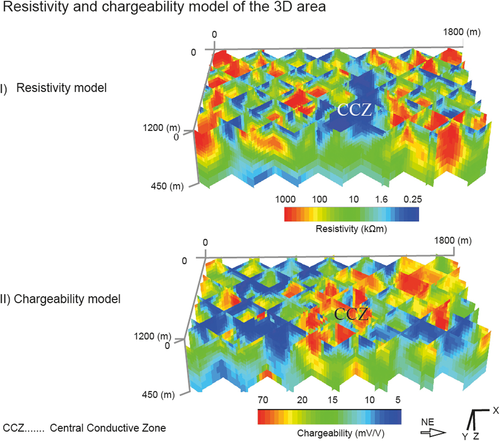
CONCLUSION
Deep 2D and 3D geoelectrical and induced polarization (IP) measurements have been conducted and interpreted in the central Skellefte District. While the combination of the geoelectrical/IP data from profiles I, II, and E-1 provided significant information about the key lithological contacts and the geometry of the major geological units at greater depths (i.e., 1.5 km), the 3D data mainly contributed to better understand the distribution of the sulphide mineralization around the three known Maurliden mineralizations and also suggested new potential areas for targeting ore deposits.
In general, deep geoelectrical/IP data proved efficient in prospecting the geological features related to the sulphide mineralizations in the Skellefte mining district. The expected presence of graphite/schist within, e.g., metasedimentary rocks of the Vargfors group, resulted in a large contrast in electric conductivity. Pole–dipole array proved suitable for targeting deep volcanogenic massive sulphide (VMS) deposits in the Skellefte District. Great investigation depth due to the good signal strength and a rather good horizontal coverage in comparison with dipole–dipole and also less sensitivity to telluric noise compared with pole–pole makes pole–dipole an interesting array for similar geological environment. However, the asymmetry associated normally in the measured apparent resistivity/IP data using pole–dipole may complicate the interpretation. In the present study, this was resolved by measuring the data in forward and reverse manner, although with the expense of extra time and cost. Better data resolution may be achieved if shallower penetration depth is desired, which needs to be determined depending on the prospecting target for each specific study.
This study resulted in the following main conclusions. (i) Based on its electrical signature, V4 is interpreted as graphitic shale/schist that was formed along a faulted contact and envelops a sulphide mineralization at ∼0.8 km in depth where the highest chargeability (S5) is observed. (ii) Several anomalies were identified on profile E-1, which, according to the results from previous petrophysical studies, are likely to be related to the alteration zones associated with the VMS deposits or graphitic schist (S1–S6), among which S5-I and S5-II are more likely to depict geological structures related to the sulphide mineralization. (iii) Vargfors basin and its key contact with the felsic volcanic rocks of the Skellefte Group were better understood based on the 2D-deep geoelectrical/IP data, and its maximum depth is estimated to ∼1 km, which is in line with earlier interpretations. (iv) The NE-dipping trend of the Jörn granodiorite, which was suggested by previous geophysical investigations, could be validated; however, resistivity and chargeability data from profile E-1 reveal that the Jörn granodiorite extends only down to 0.4-km depth. (v) The geometry of the Maurliden deposits is better understood with the help of the 3D data. Maurliden Central and its alteration halo continue at least down to 0.45 km in depth, whereas Maurliden East and North do not extend more than 0.2 km in depth. Also, several new anomalies that were imaged by the 3D resistivity and chargeability data can be interesting targets for more in-depth investigations in the future. (vi) Resistivity and IP data imaged the mafic volcanic rocks of the Skellefte Group, which occur as intercalation of basalts along the contact between felsic volcanic rocks and the Jörn granodiorites; these rocks partly underlie the outcropping felsic volcanic rocks and the Jörn granodiorite.
ACKNOWLEDGEMENTS
This work is part of the “VINNOVA 4D-modelling” project and is financed by VINNOVA and Boliden Mineral AB. The authors appreciate the constructive comments by journal Associate Editor, Prof. Ahmet Tugrul Basokur and anonymous reviewers. All project members are thanked for their contribution during the course of this work. The authors would like to thank Timo Pitkänen, Hans Thunehed, and the field crew of GeoVista AB for data acquisition and valuable comments during data processing. Tobias Hermansson and the Geophysics Department at Boliden Mineral AB are thanked for their constructive comments and provision of supplementary geophysical data. The authors would also like to thank Dr. Juliane Hübert from the Department of Earth and Atmospheric Sciences, University of Alberta, and Dr. García Juanatey from the Department of Geophysics, Uppsala University, for fruitful comments on the manuscript. And finally, Saman Tavakoli would like to thank Aija Voitkane for her unconditional support and patience when writing this paper.



